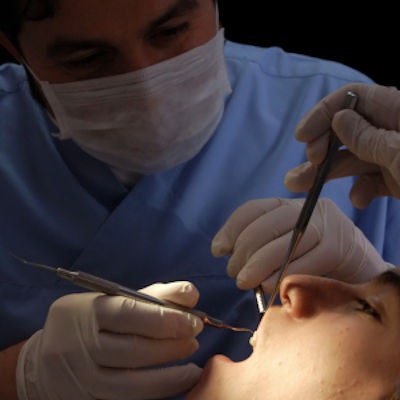
A state may have a significant share of dentists enrolled in Medicaid, but that doesn't mean they are treating these low-income patients, according to a research brief presented on October 4 by the ADA's Health Policy Institute (HPI).
Wyoming, Vermont, and Michigan have equal percentages of dentists enrolled in the U.S. program, but the number of Medicaid patients they actually treat varies considerably, Dr. Chelsea Fosse, one of the authors of the brief and a senior health policy analyst at HPI, said at the webinar.
"Overall, the level of engagement of dentists with Medicaid patients varied drastically depending on the state," she said.
Measuring enrollment
Medicaid enrollment hit record levels in 2021. To meet the needs of the nearly 75 million Medicaid-covered adults and children, dentists must participate in the state-administered program, which is funded by state and U.S. dollars. Though various metrics, including provider enrollment, patient volume, and claims, have been used to measure dentists' participation in Medicaid, the most meaningful way to capture this remains under debate.
In the past, research concerning dentist participation in Medicaid has been limited to single-state analysis or multistate analyses that did not include every state in the U.S. For the first time, information from the Transformed Medicaid Statistical Information System (T-MSIS), a national claims database that recently was made available to researchers, was used to analyze claims filed in 2017, the authors of the brief noted.
This is believed to be the first detailed analysis that explains the distribution of dentists based on the volume of Medicaid patients in the U.S., how states with similar provider enrollments have different distributions of patients, and how caseloads vary depending on dentists' race and ethnicity.
A 3-state comparison
In Michigan, Vermont, and Wyoming, 71% of dentists were enrolled as Medicaid providers in the programs in their states. However, the number of patients that dentists treated in each state varied wildly.
In Michigan, 15% of Medicaid dental providers did not see any patients enrolled in the U.S. program for low-income individuals in 2017. Only 10% of participating dentists in this state treated more than 100 Medicaid patients that year, according to the data.
More Medicaid dentists in Vermont saw more than 100 participants in 2017 than dentists in either Michigan or Wyoming. The percentage of Medicaid dentists who didn't see any patients was smaller in Wyoming and Vermont than in Michigan.
| Percentage of Medicaid patients among enrolled dentists in 3 U.S. states | |||
| Patient distribution | Michigan | Wyoming | Vermont |
| No Medicaid patients | 15% | 11% | 6% |
| 1-9 Medicaid patients | 16% | 11% | 7% |
| 10-100 Medicaid patients | 31% | 31% | 25% |
| More than 100 Medicaid patients | 10% | 18% | 34% |
Furthermore, Vermont, Montana, and Mississippi have the largest number of enrolled dentists treating more than 100 Medicaid patients. The percentage of dentists treating 100-plus patients ranged between 27% and 34%, according to the data.
On the other hand, Maine, Virginia, and Utah have the lowest number of dentists providing services to more than 100 Medicaid patients. Percentages ranged between 3% and 5%.
"This depiction of Medicaid engagement by volume of patients allows policymakers, including state Medicaid officials, to compare states using consistent yet flexible definitions of participation," according to Fosse.
Distribution by race, ethnicity
Enrollment and participation also varied by race and ethnicity. White dentists had the lowest enrollment, with 62% not participating in Medicaid. Also, white dentists who were enrolled treated the smallest number of Medicaid patients. Meanwhile, black dentists led in terms of enrollment in the program, with 61% participating. They also treated the most Medicaid patients.
| Percentage of Medicaid patients among enrolled dentists broken down by race and ethnicity | |||||
| Patient distribution | White | Black | Hispanic | Asian | American Indian, Alaska Native, Hawaiian Pacific Islander, or other |
| No Medicaid patients | 13% | 15% | 18% | 14% | 15% |
| 1-9 Medicaid patients | 4% | 4% | 3% | 3% | 4% |
| 10-100 Medicaid patients | 9% | 12% | 8% | 9% | 10% |
| More than 100 Medicaid patients | 12% | 30% | 22% | 22% | 19% |
"Do black dentists live in areas with really high reimbursements?" asked Marko Vujicic, PhD, HPI's chief economist and vice president. "I don't think that's happening."
Other factors are likely in play, said Dr. Zachary Hairston, a webinar panelist and a dental consultant for the Virginia Department of Medical Assistance Services.
"Many African Americans and Hispanics or their family members may have been recipients of these services at some point in their lives," Hairston said.
Fosse added that "socioeconomic status and earlier life experiences may have these dentists relate more to this population and serving this population."
A limitation of the research is that group dental practices may be submitting Medicaid claims under one National Provider Identifier (NPI). However, there is no way to evaluate this in the data, the authors of the brief noted.
Future studies will use the Medicaid claims data to obtain the number of patients seen in a year, as well as HPI data to determine what provider, practice, and local area characteristics drive participation and what predicts a dentist having at least one Medicaid patient. Currently, HPI is conducting research that explores whether different measures of provider participation translate into more Medicaid patients visiting dentists.
Is it dentists or patients?
If more dentists participate and see a higher volume of Medicaid patients, access is expected to improve. If that doesn't happen, it means that the main access challenges fall on the patients, they wrote.
"If the main constraints to access are on the beneficiary side such as insufficient dental care coverage, low oral health literacy, or challenges with social determinants of health like lack of transportation, then provider participation is a nonissue," the group wrote.




















